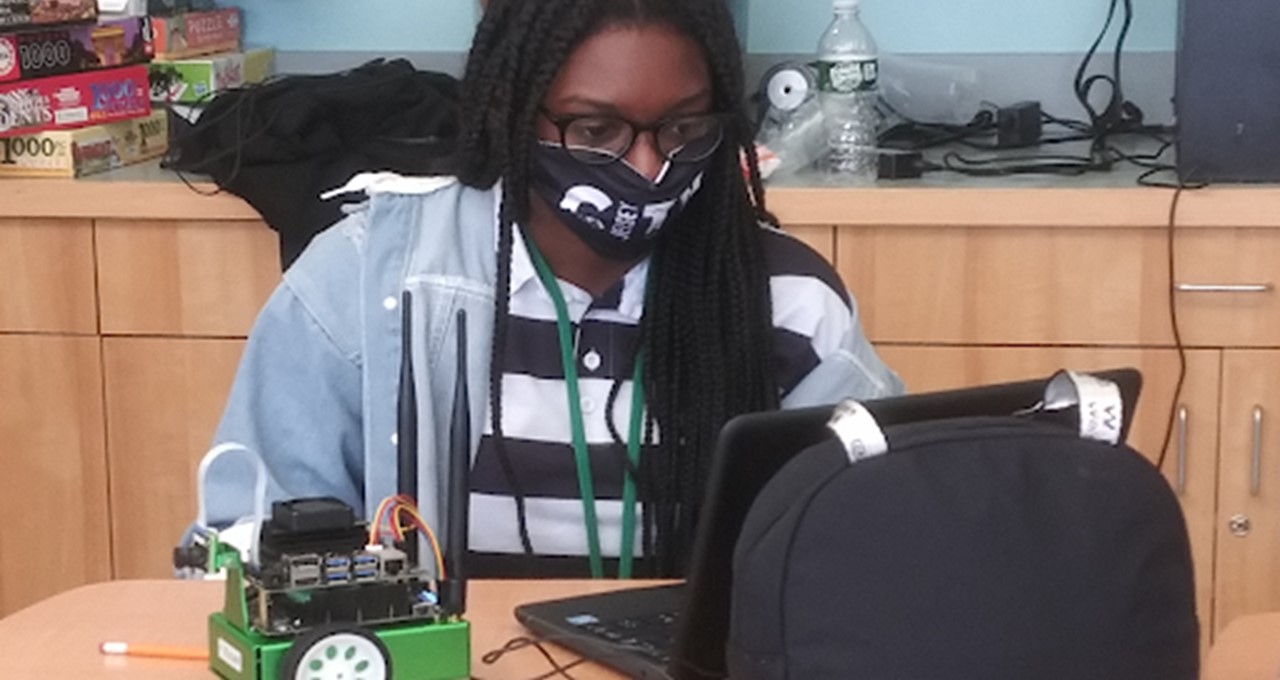Building AI projects to aid Alzheimer’s patients and monitor pedestrian safety might not be the typical way teens spend their summer.
But that’s what a dozen teens with the Boys & Girls Clubs of Hudson County, in densely packed northeastern New Jersey, did as part of the AI Pathways Institute program.
They spent three weeks brainstorming, coding and traversing spinning robots while using NVIDIA Jetson Nano 2GB developer kits and Jetbot robotics toolkits to create projects that tapped into a multitude of real-world issues. The aim was “to leave our environment and society better than we found it,” said Gail Grant, teen tech coordinator at the nonprofit.
The AI Pathways Institute program in Hudson County is an outgrowth of a successful 2019 pilot program that NVIDIA and the Boys & Girls Clubs of Western Pennsylvania partnered on. Its goals are to introduce high school students to AI and machine learning through a three-week summer camp and provide them with hands-on experience with relevant projects.
NVIDIA and the Western Pennsylvania Clubs announced this spring a new three-year partnership to scale the program to more students through the development of the AI Pathways Toolkit. The toolkit strives to make it easy for other clubs and organizations to deliver hands-on AI and robotics education to youth.
The Hudson County club — which has worked for nearly 130 years to enrich the lives of young people from disadvantaged circumstances — is among the first to adopt it.
Participating students received a cash stipend, new laptop and certificate of achievement from Carnegie Mellon University, which had previously worked with the Western Pennsylvania club. Students who scored well on a post-program exam qualified themselves for future internships.
Emboldening Students in AI
Grant said the program’s goal was to provide students with a broader sense of what AI truly entails. Moreover, she hoped to embolden students to develop and pursue newfound interests in AI and technology by providing speaker events where STEM and AI professionals highlighted their career pathways.
Sekou Sy, a 16-year-old in the AI Pathways program, was surprised to learn about the breadth of robotics — and just how much could be done with AI.
“AI is used in so many objects and ideas that I didn’t think of before,” Sy said. “It’s not just in robots, but other areas like healthcare and the environment, all of which will expand even more in the future.”
Another student, Moureau Tillman (pictured above), was already familiar with AI and the Python programming language, but AI Pathways’ focus on hands-on learning allowed her to dive deeper into AI’s real-world impact.
“Seeing as I already worked with AI, I thought the course was going to be a re-learning experience,” Tillman said. “But I learned a lot of new things through working with robots and coming up with a project that would help people other than myself.”
AI Projects in Action
The program culminated in a presentation in which students explained how they used Python to program NVIDIA Jetson-based projects that would respond to prominent, practical issues.
One project, titled “Forget-Me-Not,” employed AI to help elders and Alzheimer’s patients by alerting them about tasks and appointments, as well as providing medicine or prescription reminders.
“When brainstorming for this project, I thought about what I struggled with myself,” said Sy, who worked on the project with two teammates. “My memory is not so good, and I lose things a lot. We came up with this app where you can put in your data, and it gets to know your daily routines. Then, it reminds you about just about everything you might need.”
Other groups created proposals for projects like “Ecobot,” a robot that roams beaches and discards trash; “Safety First,” which uses AI to monitor streets and call the police when a pedestrian is in danger; and “Fresh,” a device to be placed in users’ cars and monitor outdoor air pollution.
Although not all were able to see their projects to completion, students witnessed how AI could be applied to a variety of problems. Some were even inspired to pursue tech as a career.
“These projects made me think about real-life situations that people are dealing with,” Sy said. “I loved taking it one step further by incorporating the AI aspect, as well as seeing the impact that AI can have in solving these problems. In fact, AI is a field I’m really excited to pursue in the future.”
The Hudson County club plans to reproduce the program early next year. Moving forward, Grant hopes that it’ll be a recurring one that’s implemented throughout the year.
To learn more about entry-level education on AI and robotics, watch the on-demand NVIDIA GTC sessions “Begin Your AI Journey With NVIDIA Jetson Nano” (A31723) and “Getting Started With the Edge AI and Robotics Teaching Kit” (A31535).
